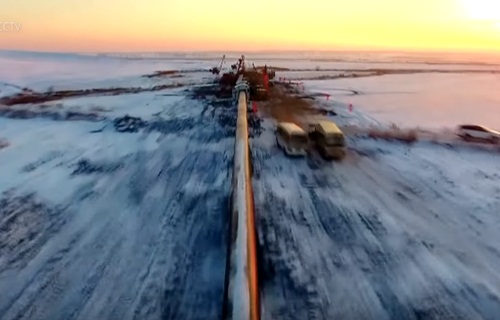Russia on Monday opened a pipeline to transport natural gas from Siberia to northeast China, in a shift of market focus from West to the East and giving a boost to economic and political ties with Beijing.
Russian President Vladimir Putin and his Chinese counterpart Xi Jinping on Monday oversaw the inauguration of the `Power of Siberia’ pipeline in a video conference.
The shift of market focus to the East will help Russia, one of the largest exporters of natural gas, skirt the adverse effects of Western financial sanctions imposed over its 2014 annexation of Ukraine’s Crimea.
Besides China, Russia is also looking at other major consumers in Asia, including India to secure potentially enormous new markets outside Europe.
Moscow is hoping to launch two other major energy projects — the Nord Steam 2 undersea Baltic gas pipeline to Germany and the TurkStream pipeline to Turkey and southern Europe.
The 3,000-km-long (1,865 mile) Power of Siberia pipeline will transport gas from the Chayandinskoye and Kovytka fields in eastern Siberia, for at least the next three decades and generate $400 billion in export revenue for Russia.
“This is a genuinely historical event not only for the global energy market but above all for us, for Russia and China,” said Putin, who watched the launch via video link from the Russian Black Sea resort of Sochi.
“This step takes Russo-Chinese strategic cooperation in energy to a qualitative new level and brings us closer to (fulfilling) the task, set together with Chinese leader Xi Jinping, of taking bilateral trade to $200 billion by 2024.”
The new pipeline extends from Heilongjiang, on the Russian border, to Jilin and Liaoning, China’s top grain hub.
Xi told Putin via a video link on Monday that the newly launched gas pipeline is “a landmark project of bilateral energy cooperation” and an “example of deep integration and mutually beneficial cooperation”.
"Other than for heating, natural gas can be used to generate power," Fuqiang Yang, an energy analyst, said. "It's much better than oil and coal. It has much less pollution and fewer emission of CO2".
Flows via the pipeline are expected to gradually rise to 38 billion cubic metres (bcm) per year in 2025, possibly making China Russia’s second-largest gas customer after Germany, which bought 58.50 bcm of gas from Russia last year.
Moscow began supplying natural gas to western and central Europe in the 1950s and Europe has long been Russia’s major consumer of gas, supplied by Kremlin-controlled energy giant Gazprom, with total annual supplies of around 200 bcm.
The price China is paying for Russian gas in the new pipeline remains a closely kept secret with various industry sources saying it is tied to the price of an oil products basket.
Neither Putin, nor Xi commented on Monday on the gas price Beijing is set to pay under the contract.
Russian pipeline gas will compete against other pipeline gas supplies to China, including from Turkmenistan, as well as against shipments of sea-borne liquefied natural gas (LNG).
Russia has been increasing gas sales to China via other routes too, such as from the Russian Far East and via Mongolia or Kazakhstan, but has not firmed up any deals.
Russia also supplies gas to China through a major oil pipeline, which today ships 600,000 barrels per day (bpd), and opened a new port at Kozmino on the Pacific. Besides it ships 200,000 bpd of gas via a pipeline crossing Kazakhstan.

























